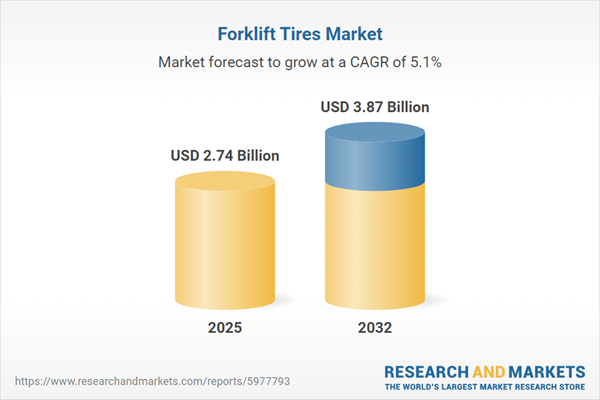Speak directly to the analyst to clarify any post sales queries you may have.
The forklift tires market is experiencing accelerated transformation as industry leaders respond to shifting logistics demands and evolving compliance requirements. Decision-makers are increasingly turning to advanced tire solutions to enhance safety, continuity, and operational performance across their global supply chains.
Forklift Tires Market Snapshot: Size and Growth Outlook
In 2024, the global forklift tires market reached USD 2.60 billion and is projected to achieve USD 2.74 billion in 2025. This trajectory signals a solid compound annual growth rate of 5.07%, with expectations for the market to attain USD 3.87 billion by 2032. Growth is driven by advances in tire materials, heightened regulatory safety standards, and increasingly complex compliance pressures. Organizations are amplifying investments in modern tire management to support logistics reliability and greater agility amid intensifying competitive landscapes.
Scope & Segmentation
- Tire Types: Foam-filled, bias pneumatic, radial pneumatic, and solid tire technologies offer tailored durability and traction. These options empower enterprises to support a range of operating environments and to optimize both operational reliability and lifecycle cost control for diverse fleet compositions.
- End-User Industries: Construction, manufacturing, logistics, warehousing, and retail sectors each prioritize unique tire requirements. Key factors include load management, site safety standards, and compliance with specific sector regulations, ensuring tire choice aligns with critical operational needs.
- Applications: Precision in tread patterns and premium rubber compounds enable custom performance for indoor and outdoor operations. These features help extend equipment life, minimize unscheduled downtime, and facilitate adherence to occupational safety and maintenance standards within busy facilities.
- Distribution Channels: Aftermarket service networks and Original Equipment Manufacturers (OEMs) remain vital for uninterrupted supply and ongoing support. Decision-makers can align servicing arrangements with fleet size, operational workloads, and preventive maintenance schedules to enhance uptime and resource control.
- Load Capacities: Tire selections are engineered to accommodate the full spectrum of forklift classes across industry. This flexibility ensures seamless adaptation as logistics sites expand or shift operating volumes, providing a foundation for ongoing fleet scalability and performance consistency.
- Regions: The Americas, Europe, Middle East, Africa, and Asia-Pacific shape procurement and operational models. Each region’s distinctive infrastructure, procurement behavior, and regulatory context influences sourcing strategies and underscores the necessity for localized and global compliance.
- Key Companies: Major contributors such as Michelin, Bridgestone, Continental, Goodyear, Sumitomo Rubber, Trelleborg, Balkrishna, Yokohama Rubber, Cheng Shin Rubber, and JK Tyre & Industries leverage broad research investments and specialized development resources. Their global presence supports the delivery of scalable solutions designed for enterprise requirements across diverse markets.
Key Takeaways for Senior Decision-Makers
- Emerging tire compositions and manufacturing methods enable measurable boosts in on-site safety and fleet uptime for businesses dependent on intensive vehicle operations.
- Industrial IoT integration and embedded tire sensors provide data-driven predictive maintenance, allowing quick identification and resolution of performance issues before they impact workflow.
- Sustainable tire compounds and retread program investments allow organizations to advance environmental stewardship while managing ongoing costs and aligning with broader corporate responsibility objectives.
- Close coordination between forklift producers and logistics teams ensures more effective fleet tracking and asset allocation, optimizing utilization and stability within high-demand environments.
- Maintaining agility in the face of regional and international regulatory shifts is vital for uninterrupted operations and resilient procurement strategies across multi-site logistics and industrial operations.
Tariff Impact on Supply Chain and Procurement Strategies
Anticipated US tariffs in 2025 are prompting many organizations to revisit procurement models, seeking to diversify supply partnerships and closely monitor inputs such as polymers and steel cords. Emphasis is increasing on optimizing domestic sourcing, updating supplier contracts for greater value, and initiating cost-effective retread programs. These proactive steps are designed to reinforce supply chain resilience and support compliance amid evolving tariff and regulatory environments.
Methodology & Data Sources
Research for this analysis integrates interviews with industry executives, reviews of current regulations, thorough secondary data analysis, and internal audit validation. This method ensures insights are reliable, actionable, and tailored to inform C-level strategy and procurement decision-making.
Why This Report Matters
- Offers organizations a structured decision-making framework for procurement, digital modernization, and compliance planning within the forklift tires market.
- Prepares companies to proactively manage shifting regulatory and operational risks while enabling stronger business continuity planning across logistics and production networks.
- Guides investment towards safety and sustainability initiatives, improving resource deployment for lasting competitive differentiation and operational resilience.
Conclusion
This report delivers the strategic intelligence and actionable analysis required for executives to build more dependable, compliant, and sustainable operations across the forklift tires industry.
Additional Product Information:
- Purchase of this report includes 1 year online access with quarterly updates.
- This report can be updated on request. Please contact our Customer Experience team using the Ask a Question widget on our website.
Table of Contents
3. Executive Summary
4. Market Overview
7. Cumulative Impact of Artificial Intelligence 2025
Companies Mentioned
The companies profiled in this Forklift Tires market report include:- Michelin SA
- Bridgestone Corporation
- Continental AG
- The Goodyear Tire & Rubber Company
- Sumitomo Rubber Industries, Ltd.
- Trelleborg AB
- Balkrishna Industries Limited
- Yokohama Rubber Company, Ltd.
- Cheng Shin Rubber Industry Co., Ltd.
- JK Tyre & Industries Limited
Table Information
| Report Attribute | Details |
|---|---|
| No. of Pages | 184 |
| Published | October 2025 |
| Forecast Period | 2025 - 2032 |
| Estimated Market Value ( USD | $ 2.74 Billion |
| Forecasted Market Value ( USD | $ 3.87 Billion |
| Compound Annual Growth Rate | 5.0% |
| Regions Covered | Global |
| No. of Companies Mentioned | 11 |









